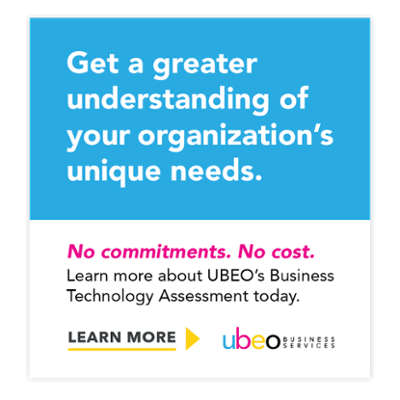Updated: April 10, 2023
Is Your Organization Embracing Change in the Printing Industry?
A lot has impacted all of us personally and professionally over the past three years. Covid, in particular, sent shock waves through the print industry and impacted workplaces throughout the world.
As an optimist, I look for ways to make the best out of any situation I find myself in. Personally, I have tried to stay positive and be grateful. Professionally I have focused on what’s next to prepare myself and UBEO to thrive in a post-Covid world.
I would like to review in this article what I think is happening in the print industry — an industry that I have worked in and enjoyed since I graduated from college decades ago.
Office Printers Took Time to Catch On

In some ways, many of us feel like printers have always been in the office. It’s hard to remember a time when there wasn’t at least one central giant causing paper jams and eating ink on a daily basis. But that change didn’t happen overnight, and there was a time when people were hesitant to invest in office copiers.
Early on in my career, I worked at Canon USA. I was a field manager but was often called in to work with the marketing team to discuss the launch of new products. One such product was the Canon GP55, which I believe was the first digital copier to hit the market. Everyone on the team thought it would quickly dominate the entire market because the technology was so advanced.
While multi-function technology did eventually come to dominate, it took twenty years to do so.
This won’t come as a surprise to people who follow technology. It takes years for people to get comfortable with change. And real (lasting) change typically follows some unexpected catalyst. Our most recent catalyst took the form of a global pandemic, and it’s important to understand the fallout and how your business should adapt.
What Makes Change So Hard?
Layers upon layers of status quo stand in front of most change. People are used to doing things a certain way. Many times, we get into behavioral ruts and don’t question those practices. Other times, people are actively resistant to change because they don’t want to learn a new thing. It takes education and a lot of hard work from leadership to drive real change.
The printing industry is no exception. People tend to have a love-hate relationship with the office printer; they want physical copies but don’t like managing the printer or staying on top of secured print practices. While multi-function printers (MFP) have become more user-friendly and offer a huge range of capabilities, people often limit themselves to using only the most basic print features.
Change is hard because it takes time and insight to pursue true innovation (and not just jump on every flashy trend).
The Process of Change
Where do you stand regarding most major changes? Not all companies change at the same pace. There are three positions within industry-wide change:
- The bleeding edge (trying brand new technology while it still has bugs)
- The cutting edge (early adoption of advanced processes before the masses)
- The herd (mainstream change once it becomes the expected norm)
 Typically companies on the cutting edge benefit the most from their position because early adoption of innovative technology gives them an advantage over their competition. Those on the bleeding edge have to navigate a lot of issues that come with untested technology. Those in the herd are simply following industry norms but have proven processes they can follow. And I should note that, even in the herd, you have stragglers who are resistant to change and only do so when pressured by consumer expectations or regulatory standards.
Typically companies on the cutting edge benefit the most from their position because early adoption of innovative technology gives them an advantage over their competition. Those on the bleeding edge have to navigate a lot of issues that come with untested technology. Those in the herd are simply following industry norms but have proven processes they can follow. And I should note that, even in the herd, you have stragglers who are resistant to change and only do so when pressured by consumer expectations or regulatory standards.
Essentially all technology goes through this journey; the computer industry had to deal with people that were attached to their IBM Selectric typewriter, electronic tolling dealt with people who had credit card fears or liked talking to the toll operators, people were nervous about trusting GPS over paper maps, and so on. Change happens, but it takes a while for people to get over their concerns and default to the new normal.
We all accept change faster when it solves an obvious pain. Uber is a great example, coming in to disrupt a system many disliked. The taxi industry (on the whole) held all of us hostage for decades with poor customer service and high prices — then along came Uber, with dynamic pricing, high-quality drivers, and a convenient app to order services and simplify payments.
 So where are we with the office printer?
So where are we with the office printer?
The staple of the workplace has been a fixture for over 60 years since its introduction into the office by Xerox. The office printer is featured in movies and is often the butt of many workplace jokes. They became so central to work that people even brought smaller versions into their home offices. My wife informed me that if I didn’t get one for our condo in Austin, she was going to go out and buy one from the competition!
But 60 years of mainstream use hasn’t happened without a lot of change in the printing industry and the devices now taking up your office floor space. If you think office copiers are pretty much the same machines they were 20 years ago, then you are part of the herd and missing out on a lot of crucial opportunities to improve your business workflow.
The Cutting Edge in Office MFP Machines
The future of print isn’t demise; it’s a shifting of priorities. If I said that local old-school taxis are in serious decline, I would be correct. But If I said Uber has become the new and improved “taxi” and has expanded their market, I would also be correct. The taxi industry isn’t dying, but priorities have shifted and cutting-edge companies can take advantage of filling that need.
What Is the Latest Printing Technology?
Calling today’s MFP just a copier or a printer is a disservice to all that it can do. Unless you really have a 20-year-old copier, your office devices can probably do a lot more than just make copies. The modern office device still makes copies, but it also:
- Blocks hackers from getting into your network
- Scans documents for email or digital document management
- Stores and retrieves critical information
- Tracks and manages print jobs
- Provides secure user profiles for increased security
- Helps companies track and control print spend
- Provides better visibility over your entire print network
And because of this change, the MFP remains a conduit for most communication in essentially every business. Being on the cutting edge of the print industry means adopting the software and devices that create a powerful business ecosystem.
Many companies use knowledgeable outside partners to help them stay on the cutting edge and understand the latest solutions available on the market. Companies need devices that work seamlessly with their processes, integrate with their other systems, and support their unique business needs.
What Is Happening in the Printing Industry?
 Prior to Covid, only a fraction of our customers were interested in getting the most out of their printers. Post Covid, about 80% of our customers are interested in how their printers can support improved workflows, document management, and data security. The herd is starting to move, and businesses that aren’t looking into print market trends will soon be left in the dust.
Prior to Covid, only a fraction of our customers were interested in getting the most out of their printers. Post Covid, about 80% of our customers are interested in how their printers can support improved workflows, document management, and data security. The herd is starting to move, and businesses that aren’t looking into print market trends will soon be left in the dust.
The graphics market is exploding; organizations need signage and advertising, but the printing press has been slowly going away for years — all that volume has transitioned to convenient premium production printers that support sharp graphics, print customizations, and wide-format capabilities. Schools and hospitals have migrated much of their reading material to print and need a secure way to manage sensitive information.
The software field for print is also exploding, driven by a real need to secure and improve communication inside all companies. With digital migration, the herd has turned into a stampede. To adapt to changing demand, copier companies must transition to office technology and services platforms.
Challenges Facing the Printing Industry
Many organizations are working with outdated office copiers and desperately need to restructure their print ecosystem. The issue with many copier distributors, including the manufacturers, is that they have been waiting so long for this shift to happen that they have not recognized the impact Covid has had on the need for print. Many just aren’t prepared for the herd.
Several points of distribution have cut staff to maintain profit levels. This reality has put some distributors and customers in a vulnerable position because the need is NOW. The market share has grown for those ready to take advantage of it.
People are returning to the office and school (and they never left the hospital, clinic, warehouse, plant, etc.), and they are using the machines.
The problem is: it is no longer just a copy machine. These crucial devices are vulnerable to hackers and other network issues — potentially crippling your business. If the company you purchased your equipment from is not up to speed, you are out of luck and stuck with something worse than the old yellow cab.
What is the Future of Managed Print Services?

For years, UBEO has catered to the high end of the market, offering technical support and exceptional service for companies pursuing the cutting edge. Over time, a focus on managed print services has shifted to printer standardization to simplify the print environment and improve security.
Seeing the writing on the wall, we positioned our entire company to provide print standardization services to a much larger portion of our customers as they looked for managed print support and optimized solutions. UBEO has prepared to meet the future of office print with several key initiatives, including:
- Establishing ProIT — an entire division that focuses on customer transformation and technical expertise of document workflow and security.
- Hiring and training dozens of analysts and technical resources to seamlessly help our customers move into the cutting-edge transformation process.
- Acquiring print businesses throughout the U.S. to expand our reach with experienced industry professionals.
- Creating a Business Technology Assessment that helps companies understand their unique challenges and pinpoint solutions to improve security, workflows, and costs.
As a result, our sales are up significantly, and our customers are happier than ever. Our sales and support teams are helping new customers learn about the latest capabilities every day.
In a nutshell, the copier business is alive and well for those companies and customers who are willing to accept the changing landscape. For those that are not ready, it’s going to be a bumpy ride. The good news is, you still have time to update your print ecosystem before you become the trailing end of the herd.
Your choice is to insource the expertise — or hire a company to help you. If you want a partner to help you identify the right setup and processes for your company, we can help. Talk to our team today to get your free Business Technology Assessment and find out how you can be on the cutting edge of change.
Change is here. We can help.
Jim Morrissey
Jim is a “big picture” executive recognizing that success relies upon strategic thinking with many components, which include a clear vision and strategy, organizational alignment, goal setting, and Key Performance Indicators (KPIs), and effective market penetration and branding. He builds an organizational structure...


